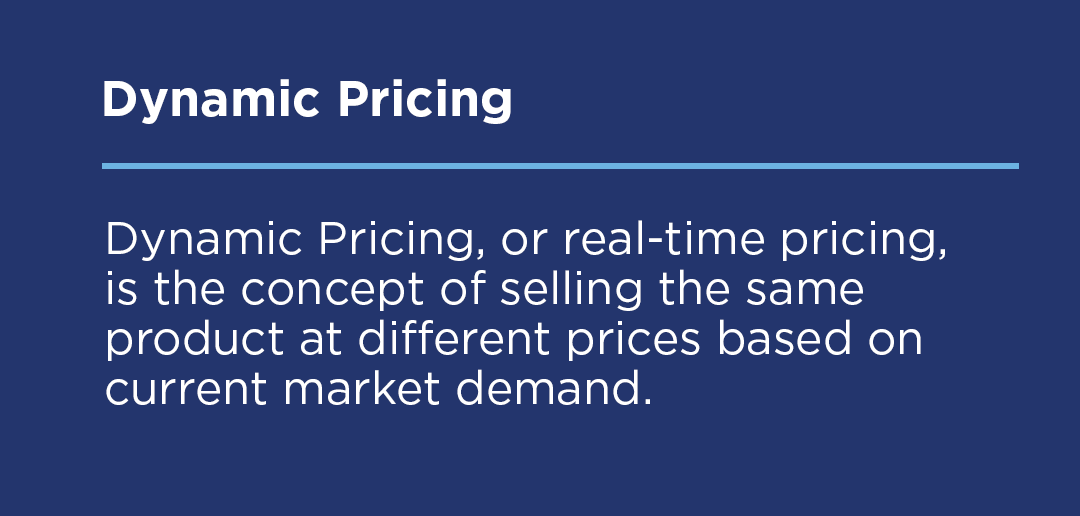Have you noticed online prices change from one day to the next, even when you’re browsing the same site? It’s not your imagination that this is happening more frequently. You’re experiencing dynamic pricing. Once you understand how it works, you’ll be a smarter consumer in a better position to protect your budget.
Explaining Dynamic Pricing
Dynamic pricing is a strategy that more online and even brick and mortar stores and other businesses are using to make more money by changing their prices in real time based on factors like these:
- Overall consumer demand for items
- Their competitors’ prices for the same items
- The time of the day, week, month or year
- The physical location in which you’re shopping
- Your individual buying habits
- The buying habits of particular groups based on gender, age, marital status, family situation or business versus consumer customer
It’s not a new strategy, just one becoming more prevalent as society spends more time in the digital world, which allows businesses to gather and analyze more data about all of us.

Dynamic pricing makes it easy for businesses to charge higher prices when it’s most advantageous. They also use it to influence customer behavior. For example, retailers may nudge you to buy an item that’s been sitting in your online shopping cart for several days through tactics like these:
- Lowering the price
- Offering you a discount
- Sending you a coupon
- Indicating that supplies are low
Depending on how a business uses it, dynamic pricing can also be referred to as surge pricing, demand pricing or time-based pricing.
How to Recognize It
Before cell phones, rates for long distance calls varied by the day of the week and the time of day. This is an older example of dynamic pricing, but it still had a static element to it because prices changed in the same way and at the same time every week. Today’s dynamic pricing tends to happen in real time because prices can be automatically adjusted through a company’s computer system as conditions change.
In addition to retail shopping, other common examples of dynamic pricing include the following:
- Ride-sharing services: Sites like Uber and Lyft adjust the price you pay at any given time based on how much demand there is for rides. The higher the demand, the more you pay.
- Hotels: The number of available rooms, the timing of your stay and events going on nearby can all impact your room price at booking.
- Airlines: The type of seat you want, the lead time of your booking and your travel dates and times can affect the price of your ticket.
- Public parking: The more people who need to park because of an event or the time of day or day of the week can alter the price of a space.
- Events: When seats remain for athletic games, concerts or other performances as the scheduled event gets closer, promoters may lower ticket prices to ensure they sell as many as possible. (Flip side? When demand is high, prices go up.)
- Utilities: Some electric and natural gas companies adjust their prices based on consumer demand at a given time of year or day.
Some restaurants are even experimenting with dynamic pricing beyond their long-time use of happy hour specials and kids-eat-free nights.
Making Dynamic Pricing Work for You
Understanding how businesses use dynamic pricing to their benefit is the first step in making sure it isn’t one of the things that will ruin your budget. The second is making it work to your advantage by employing smart money strategies like these:
- Comparison shopping: It’s easier than ever to know who has the best price on a given item with online tools from the major search engines, such as Bing Shopping, Google Shopping, and Yahoo Shopping, or through price comparison apps like BuyVia, Flipp and ShopSavvy.
- Price matching: Many major retailers will match the prices of designated competitors. Find out the policy at your favorite retailer and use your comparison shopping tool to get better prices where you prefer to shop.
- Signing up for price alerts: Sites like Expedia, Kayak and Travelocity offer price alerts on travel deals if you create an account. For retail shopping, camelcamelcamel alerts you to price changes on Amazon, and Price.com and Honey’s DropList do the same for a wide range of retailers.
- Practicing patience: Unless it’s an item that you need immediately, wait for the price to drop or the store to run a sale. If you’re online, let your desired item sit in your online shopping cart for a bit to see if the business will lower the price for you or send you a coupon to get you to buy.
- Changing locations: More popular locations of your favorite retailer may charge higher prices than the ones less frequented. You can take advantage of this by going to the latter or using its zip code when shopping online.
- Going incognito online: Some (but not all, especially travel experts) personal finance pundits believe you can avoid dynamic pricing by opening a “new incognito window” from your browser settings when shopping online. An incognito window keeps your identity private. This means any websites you visit from that tab have no prior history on you and categorize you as a new shopper. It might be worth experimenting to see if you notice a difference. (Be sure to tell us about your experience in the comments!)
- Clearing cookies: You might also can try clearing the cookies from your browser settings to erase the data that websites have collected on you while you were visiting them.
Now that you understand dynamic pricing, you’re more likely to notice and do something about it to ensure you stick to your budget and your budget rules.
Editor’s note: Quorum is not affiliated with any of the companies mentioned in this article and derives no benefit from these businesses for placement in this article.






Comments Section
Please note: Comments are not monitored for member servicing inquiries and will not be published. If you have a question or comment about a Quorum product or account, please visit quorumfcu.org to submit a query with our Member Service Team. Thank you.